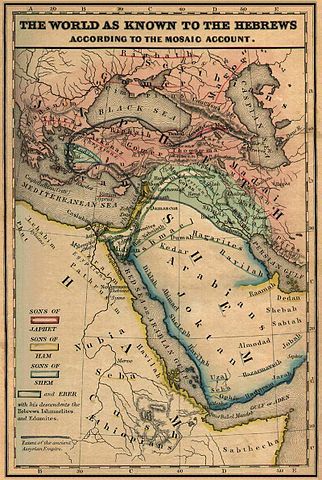
Ashkenaz is shown in Phrygia in this 1854 map of “The World as known to the Hebrews” (Lyman Coleman, Historical Textbook and Atlas of Biblical Geography) | (c) en.wikipedia.org/wiki/Ashkenaz
In this blog, we will delve into the fascinating question of where Ashkenazi Jews actually originated. While their roots can be traced back to the 12th century literary tradition, it is believed that the earliest Ashkenazi Jewish communities were comprised mainly of Jews from northern Italy. The migration of the colonymous family from northern Italy to the region of Ashkenaz played a significant role in the formation of these communities.
Immerse yourself in a captivating voyage along the river as we invite you to join Kosher Riverboat Cruises in a quest to deepen your knowledge of our shared heritage. Indulge in an extraordinary Jewish travel experience, where you’ll relish in refined kosher dining, daily services, and stylish accommodations. Delight in exploring magnificent destinations while luxuriating onboard our exquisite vessel. Prepare for an extraordinary Jewish vacation that transcends the ordinary and leaves an indelible mark on your historical journey.
The Enigmatic Remains of Norwich’s Medieval Well
One intriguing discovery shedding light on Ashkenazi Jewish history occurred during the construction of a shopping center in Norwich, England. A medieval well was unearthed, containing a grim accumulation of human corpses. These remains were later confirmed through modern genetic analysis to belong to Ashkenazi Jews, possibly victims of a 12th-century riot associated with a crusade. The DNA evidence not only provided insights into their physical appearance but also established their close relationship to contemporary Ashkenazi Jews.
While the Norwich discovery confirmed the presence of Ashkenazi Jews in 12th-century England, further exploration of their origins led to a complex study centered around a cemetery in Erfurt, Germany. Unlike the Norwich remains, the context of the Erfurt findings provided a clearer understanding of the historical events surrounding the community. Various factors contributed to the integration of Ashkenazi Jews into the local population, including conversion and encounters with non-Jews through marriage and relationships.
The Impact of Roman Jewish Wars
An essential historical event shaping the Ashkenazi Jewish population occurred after the first and second Roman Jewish wars, particularly the Bar Kokhba Rebellion in 135 CE. Many Jews were sent as slaves to the Italian peninsula, resulting in the establishment of a significant Jewish population there. Interactions with both South and North Italians, through both rabbinic conversions and other relationships, contributed to the blending of Jewish and Italian heritage.
Insights from 9th-Century Journey and Erfurt Remains
In the 9th century, a small group of Jews, led by the colonymous family, embarked on a journey from the land of Israel, traversing the Italian peninsula, and settling in the Rhineland. This marked the foundation of the Ashkenazi Jewish community in Ashkenaz. The discovery of remains in Erfurt, dating back to 1351, yielded fascinating insights. Notably, these findings debunked the Khazarian thesis, which proposed a massive conversion event in Eastern Europe in the 8th century as the origin of Ashkenazi Jews. The DNA analysis of the Erfurt remains revealed Middle Eastern ancestry ranging from 15% to 45% and Italian ancestry from 45% to 70%, explaining the distinct physical characteristics of Ashkenazi Jews compared to Sephardic Mizrahi or North African Jews.
The story of Ashkenazi Jews continues with their migration to Eastern Europe, particularly to regions such as Poland and Lithuania in the 14th century and beyond. The movement and further developments in Eastern Europe add another layer to the rich tapestry of Ashkenazi Jewish history. Join us as we explore the intricate journey and heritage of Ashkenazi Jews, uncovering the threads that connect them to their origins and shape their unique identity
